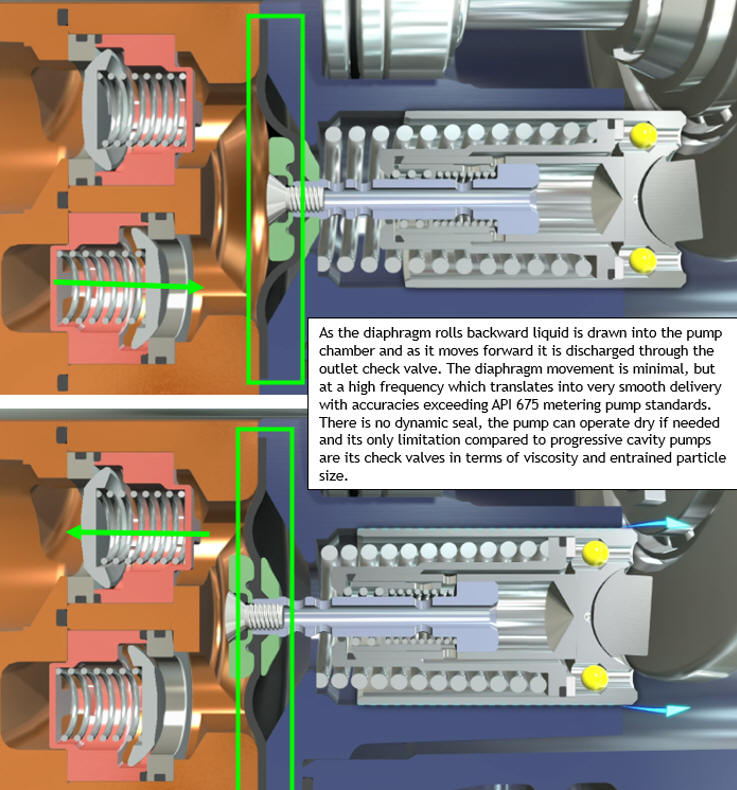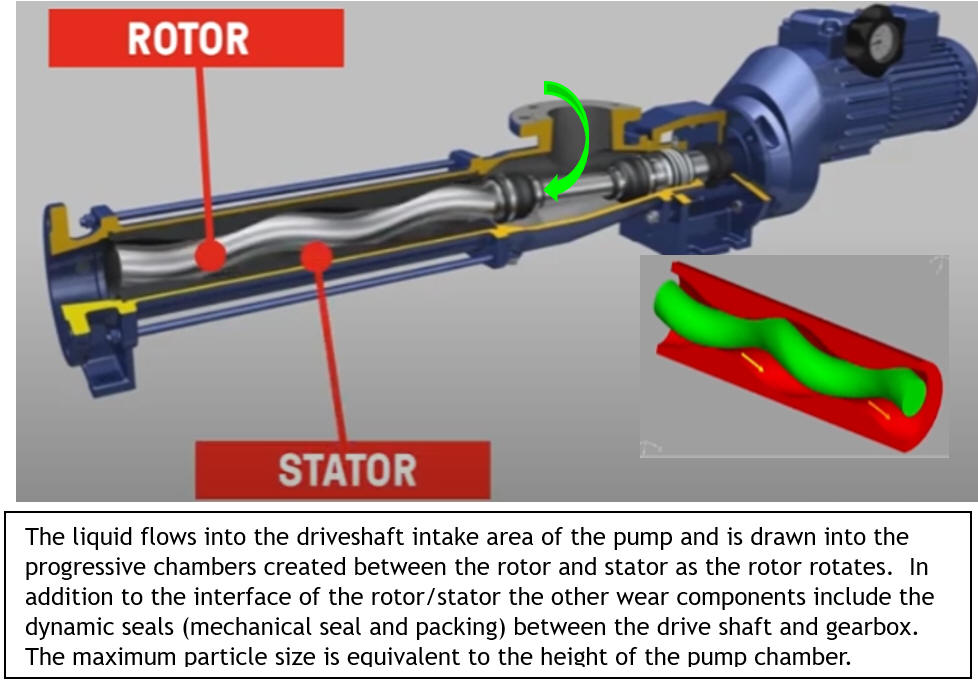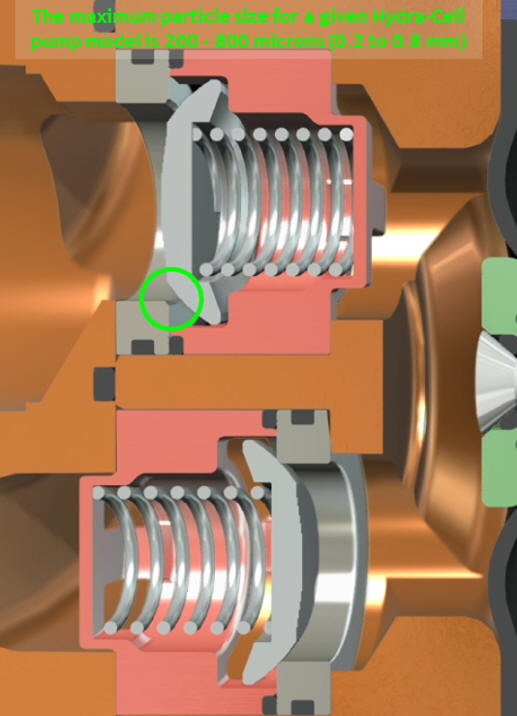Wanner™ Hydra-Cell®
Pro Pump vs. Progressive
Cavity Pumps:
A Comprehensive Comparison and Real-World
Applications
Introduction
Wanner™ Hydra-Cell® Pro Pump pumps and progressive cavity pumps share a common feature – they are both positive displacement pumps known for their ability to handle challenging liquids. While Hydra Cell Pro pumps have gained prominence due to their sealless design, it's important to note that progressive cavity pumps excel in specific applications. In this article, we will delve into both designs, providing a comprehensive comparison and real-world application examples.
Overview
The Hydra Cell Pro pump series covers a broad flow range, from 0.06 GPH to 157 GPM, with an operating pressure range spanning 30 PSIG up to 5000 PSIG. These pumps are available with simplex, triplex, and quintuplex pump chambers, offering both synchronous and asynchronous reciprocating designs. Some key features of Hydra Cell Pro pumps include:
-
Gentle pumping action: Virtually pulse-free operation.
-
Self-priming capability: Ensures ease of use.
-
Handling of liquids and slurries with solids up to 0.8mm.
-
Temperature resistance: Can handle liquids up to 230°F.Operates dry without damage.
-
Viscous liquids: Can pump liquids up to approximately 20,000 cP.

Progressing cavity pumps, on the other hand, cater to larger flow rates (exceeding 2000 GPM) and can manage higher viscosity liquids, larger particles and higher concentrations of slurries. However, their pressure capacity is limited, usually topping out at around 700 PSIG and they have a sealed design. Their key attributes include:
-
Smooth pumping action:
-
Ensuring efficient operation.
-
Self-priming feature: Simplifying startup.
-
Solids handling: Suitable for liquids with solids and slurries.
-
Temperature resistance: Can handle liquids up to 350°F.
-
Dry operation: Some designs can operate with minimal accelerated wear.
-
High viscosity: Can pump liquids up to 1,000,000 cP.

Designs
Hydra Cell Pro pumps move liquid through the pump head using 1, 3, or 5 internal pump chambers connected to a common inlet and outlet port. A hydraulically balanced diaphragm is responsible for increasing and decreasing the volume within each pump chamber. The diaphragm style seal is non-dynamic, and it can "roll" into and out of the pump chamber. The movement is driven by a hydraulic column that self-adjusts with each stroke to overcome discharge restrictions. The hydraulic liquid is typically a standard synthetic motor oil, and the pumping action is highly efficient, with minimal wear components.

Progressing cavity pumps employ a different mechanism, using rotating rotors within stationary stators to move liquid progressively from the inlet to the outlet. The stator's helix-like design forms pockets of trapped liquid per shaft rotation, moving it towards the discharge port. The main wear point is the compression between the rotor and stator, which can be adjusted to accommodate for minor wear. The pump manifold is isolated from the gearbox by packing or a mechanical seal, which are subject to wear and leakage. Progressing cavity pumps can reverse the flow by rotating the stator in the opposite direction and can be installed horizontally or vertically.

Comparing the Two Designs
The choice between Hydra Cell Pro and progressing cavity pumps depends on the specific requirements of the application. Progressive cavity pumps have an inherent flexibility, excelling in pumping larger solids, higher viscosities, thicker slurries, and hotter liquids.
Hydra Cell Pro pumps, in contrast, have internal check valves as their primary wear component and are limited in maximum particle size compared to progressive cavity pumps. While some Hydra Cell Pro pumps can be installed vertically, most are designed for horizontal installation.
For applications involving pumping slurries for water treatment, such as lime slurry or milk of magnesia, both pump designs can be suitable, with Hydra Cell Pro offering specific advantages.
Progressive cavity pumps can be more expensive to maintain, particularly for larger sizes. Replacing stators and rotors can be challenging due to the pump body's length. In contrast, changing check valves on a Hydra Cell Pro pump is relatively straightforward, and it requires minimal disturbance of piping.
Robustness
Having over 30 years of field experience with Hydra Cell Pro pumps I can state with confidence that it is tough to find a more compact and rugged pump design for the flow rates and applications applicable to Hydra Cell Pro pumps. Not only are they undamaged by inlet cavitation and running dry, but this also means that less process instrumentation is required to “protect” the pump system (ie. low level switches). It is encouraged to run the pump dry prior to long term storage, especially where freezing conditions are possible.
The pump shaft rotational direction doesn’t matter, and that simplifies the electrical aspect of installation. Hydra Cell Pro pumps for flow rates up to 20 GPM can be mounted to NEMA c-faced motors via an adapter which automatically aligns the pump and motor shafts such that shaft couplings are not wearing out prematurely.
Frequency of Maintenance
This varies depending on materials and operating conditions. Hydra Cell Pro check valves are offered in a variety of materials to resist chemical attack and erosion (stainless steel, ceramic, tungsten carbide, Hastelloy). I know from personal experience pumping a 25% concentration of lime slurry for flue gas desulphurization that ceramic check valves will last from 4000 to 6000 hours before they require replacing. As they wear, the pumping efficiency decreases and the pumping action becomes less smooth. There is no leakage or sudden non-pumping situation. The only other maintenance required is replacing the oil every 4000-6000 hours depending upon the pump model and operating pressure. A 10-15 GPM application requiring ceramic check valves would cost about $1800 to service in 2023.
I couldn’t find estimated wear life for stators and rotors because their wear is liquid and process dependent; for example, operating them dry accelerates stator wear significantly. In addition to stators and rotors, progressing cavity pumps have packing and mechanical seals for the driveshaft of the rotor, so they are be more expensive to maintain and require special tools. Progressive cavity pumps are not ideal for applications that benefit from in-field repair functionality.
Precision Metering Applications
While progressive cavity pumps can handle fractional GPH pumping, they are not considered true "metering pumps" as per API 675 metering pump performance standards. In this regard, Hydra-Cell pumps exceed those specifications, offering superior linearity, repeatability, and steady-state accuracy.
Deciding Factors
When choosing between the two pump designs, consider factors like flow range, pressure requirements, and liquid characteristics. In scenarios where both pumps can be used, Hydra Cell Pro is generally the more efficient, compact, and reliable choice.
Progressive cavity pumps may cost less for high flow rate applications requiring lower pressures. They are also a better choice for high viscosity liquids, concentrated slurries, entrained particles >0.8µ<40.0µ and stringy shaped particulates.





